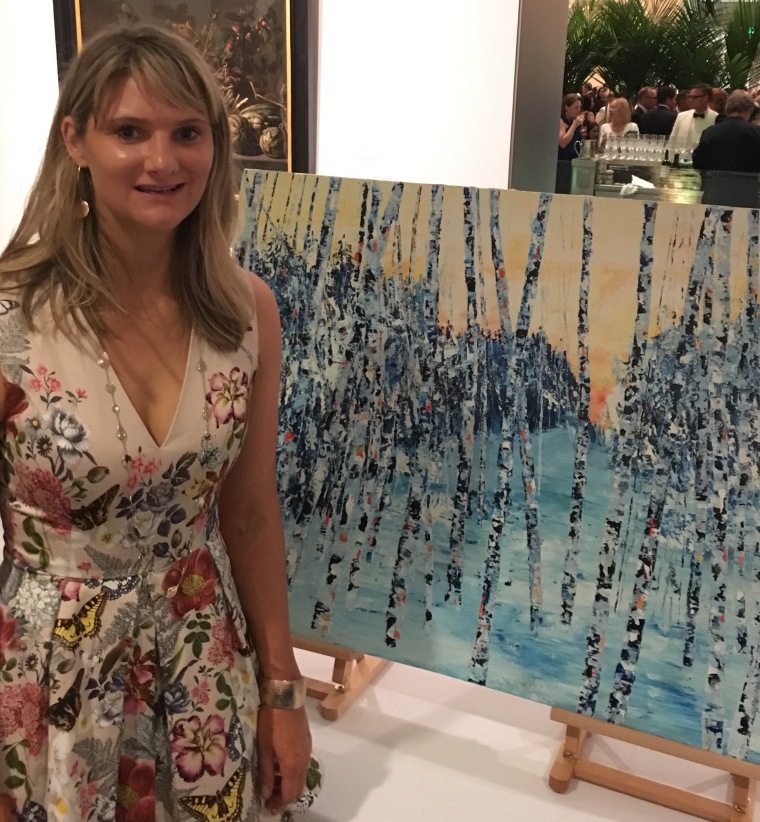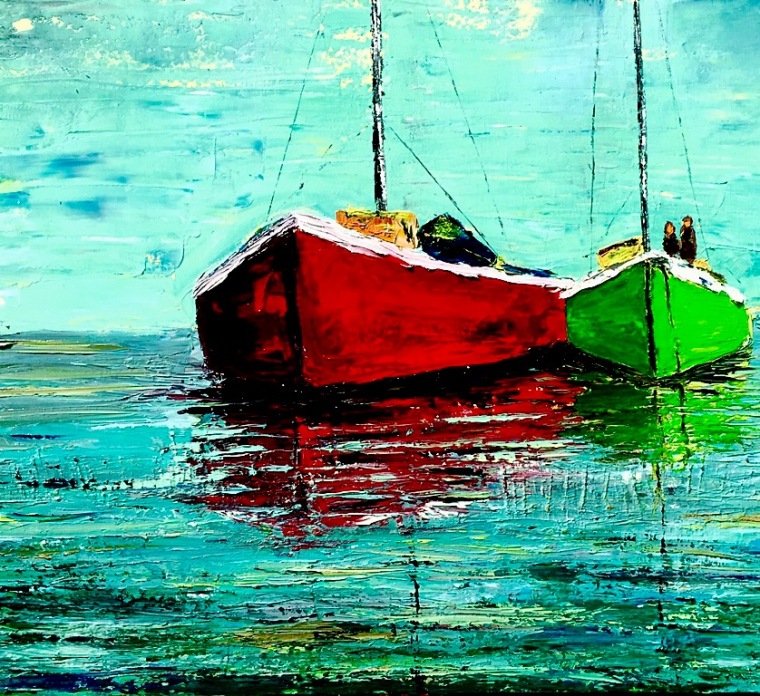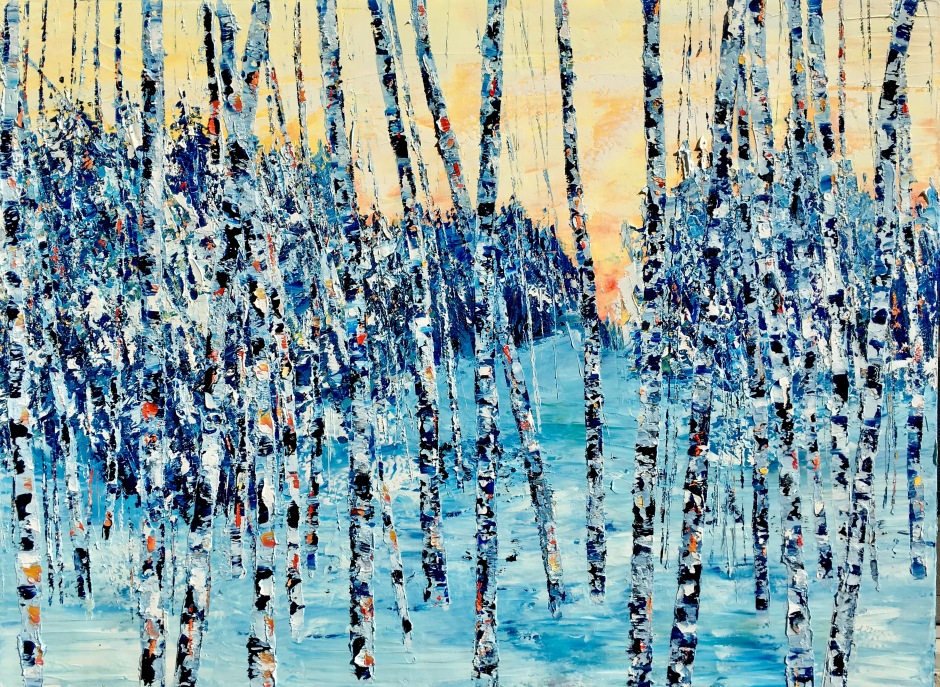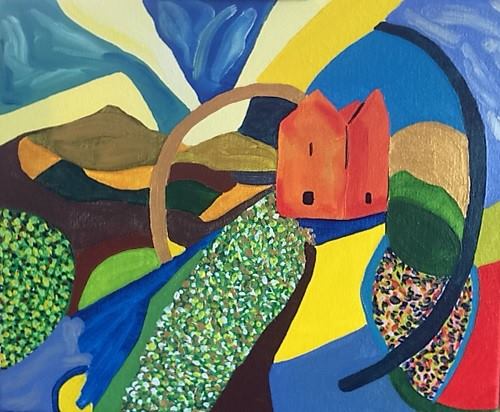I spoke to American-born Artist Julia S. Powell to ask about her stunning oil collections; including her most-bid on piece at the Museum of Fine Arts Boston Summer Auction of 2016. The inspiration behind her nature-based paintings (that with their bold, eye-catching colours change the perspective in which you see the seasons) and how some of her pieces featured on TV’s The Mindy Project.
I’m the first to admit that when I scroll through a new Instagram page, I very much become intensely captivated by the new theme or vibe the creator is going for. I was nonetheless mesmerised by all the colours and textures creeping up on me when I came across Julia Powell. When I saw videos of layers being placed upon layers of paint I was instantly fascinated. Therefore, when I first spoke to Powell I was eager to know how her visuals became so alive: “I like to look at a lot of landscape photographs, trudge about outside looking at nature, and look at paintings that inspire me. I get images in my head and then, when I’m back in the studio, I want to capture those images, but in hyper-colour.” She goes on to illustrate how that textured effect that’s so captivating doesn’t come without its problems in the creation process: “Most of my oil paintings have between four and seven layers of paint so I’m often painting about five paintings at the same time while I wait for some to dry”

The majority of Powell’s paintings are done with oil, but every now and again you’ll catch sight of a soft pastel or watercolour: “I prefer oil but it’s messy and hard to clean up as it just gets everywhere! After a while I need to change to something simpler and easier (and something that doesn’t make my eyes hurt!).” Although the practicalities of the medium has its downfalls she expresses “But there is nothing – nothing – like the richness of oil colour, and colour is an important component of my work.” In addition to claiming oils as her favourite she notes that using watercolour gives her a sense of nostalgia towards her early days as an enthusiastic artist: “I grew up using watercolour (that’s the medium I used to teach myself how to paint), so not only is it more relaxing with less clean-up, it also reminds me of when I was a kid experimenting.”
This self-teaching comes as no surprise as Powell confirms art was more of a hobby through her time at University in which she now holds degrees from both Stanford and Yale. Although, she admits to being a serious student she also adds “my notebooks were covered with drawings and I would secretly watercolour from time to time.” Following on, I asked her if art was ever the end objective, and how she feels now that being an Artist is a full time occupation: “Honestly, the harder I worked at it, the better I got, and the more intensely I cared. I still work very, very hard, every single day trying to get better and more creative. This is what makes it such an intense and valuable profession but also, at times, incredibly exhausting. I still practice law twenty hours a week because I enjoy it, but I financially support myself from my art, not my law. My art career is much more financially rewarding than my law career at this point.” I was quite taken back when Powell went on to state: “I actually find law relaxing, as opposed to the ups and downs of art. I also have an amazing and supportive law boss, so I think I’ll practice with him until he retires.” She points out how the balance between her creative and academic sides help her along the way: “I think practising law makes me a better artist and painting makes me a better lawyer. My brain is active and easily diverted so it’s good to force it to switch gears every other day.”
When you scroll through Powell’s website each series has its own individual feel to it, through the colours and tones of the different paintings, each is as fantastic as the next, but when you come across her Birch Series there’s one in particular that captures your eye more than the others. Birch Series 6 was the highest-selling and most-bid on piece at the MFA Summer Auction this year! Flicking through, this particular piece along with 4 & 7 of the same series were personal favourites of mine. I was intrigued to find out what Powell thought made this particular piece such a unique one: “People were just especially drawn to the warm sunset paired with the cool birches.” Whilst the collection provides different perspectives of the same landscape I wanted to find out if she knew it was going to be a showstopper: “The short answer is no. I did a series of ten paintings for my 2016 Winter Birch Series and that was just the 6th. I loved it, but I also loved two others just as much.” Jokingly she adds, “If I knew which paintings would be showstoppers, I’d only try to create those ones”

Her Ironbound collection is creatively very similar: “Ironbound – like my Birch Series – is based on something in nature that I adore – that place where the land (in this case rock) meets the water. Birch trees and water reflections are probably my two favourite things to paint and when I get focused on something I get really intensely focused…so it’s not surprising to me that I’d get obsessed with certain topics.” Her obsession and enthusiasm with both series clearly comes across as she says she aims to do a Series of both each year to see how they change…“We’ll see if I stick to this!” This fascination with the surrounding nature of her hometown Cambridge Massachusetts is evidently a huge influence on her work. Despite having painted them all, I seemed to stump Powell when I asked which was her favourite season “This is too hard to answer! I have no idea.” I guess if she did have a favourite we wouldn’t see all the beautiful contrasting collections we see today. Yet, adding on she goes: “But I’ll say this: I’m always ready for the next season. I’m full on in fall mode now, but in a month I’ll be ready for winter. And by March I’ll be itching to get to spring.”
If you’re a fan of FOX’s The Mindy Project you may have noticed the vibrant pieces of art that hang on the wall, which are actually originals of Powell. “Mindy and I went to high school together and she’s a good friend.” In a simple short story, Powell explains the collaboration happened when Mindy [Kaling] came round to her house one day: “She just loved my work at this point I hadn’t told her I had started taking painting seriously, and she had started collecting for the show and for her own personal collection.” Kaling having created the awarding-winning FOX series, obviously shares a creative side of her own: “She’s wonderful to talk to about trying to find creative success in a male saturated profession. Just like writing/directing, painting is dominated by men at the elite levels. We both aim to change this!”

In association in their aim to change the male dominated world of creative profession, Powell partnered up with Agora, founded and run by her brother, Ben Powell. She donates part of her profit to the Agora Campaign Accelerate Women Now which uses digital media to highlight the voices of women entrepreneurs who have faced gender bias on their road to success. She believes “the biggest way that developing countries can continue their growth is to empower women in those countries.” She explains her charitable giving is: “always drawn to two main types: one that helps various causes related to the environment and one that helps various causes related to women. I donate paintings to auctions for nature/environment-related organizations and I give money to various organizations that help women – both in the US and internationally.” When speaking to Powell it’s obvious that her work is a representation of the professionalism in Women in which she aims to promote: although her art may deem challenging at times, she focuses constantly at improving, and aspires everyday at being even better than she was the day before. As a result she produces the most stunning visuals that if you haven’t already checked out you should go and do so now!
For more of her beautiful pieces follow Julia on Instagram @juliaspowell10 , like her Facebook page Julia S Powell Art, or simply check out her website www.juliaspowell.com
All images are owned by Julia S. Powell






